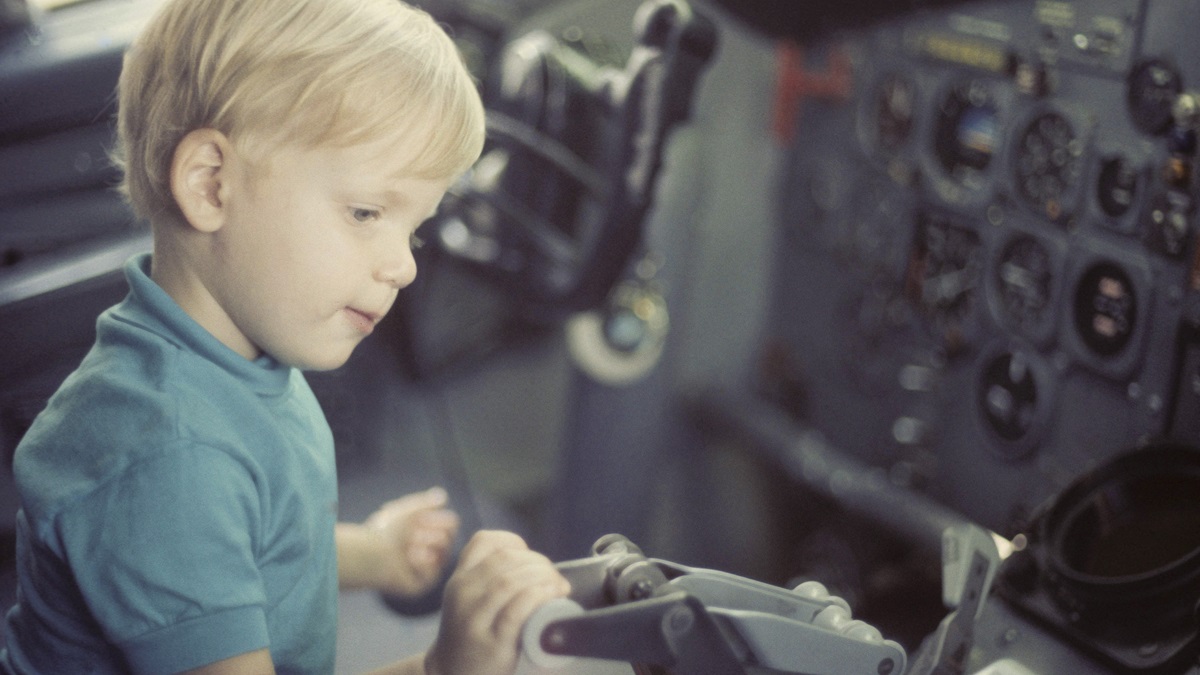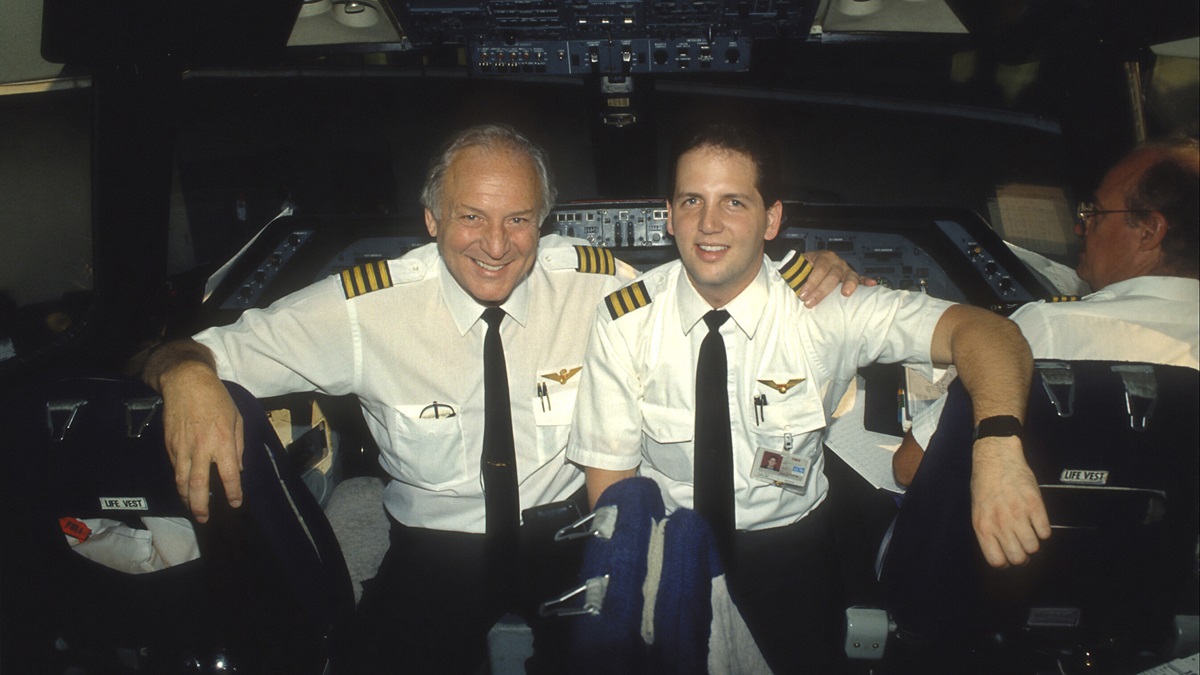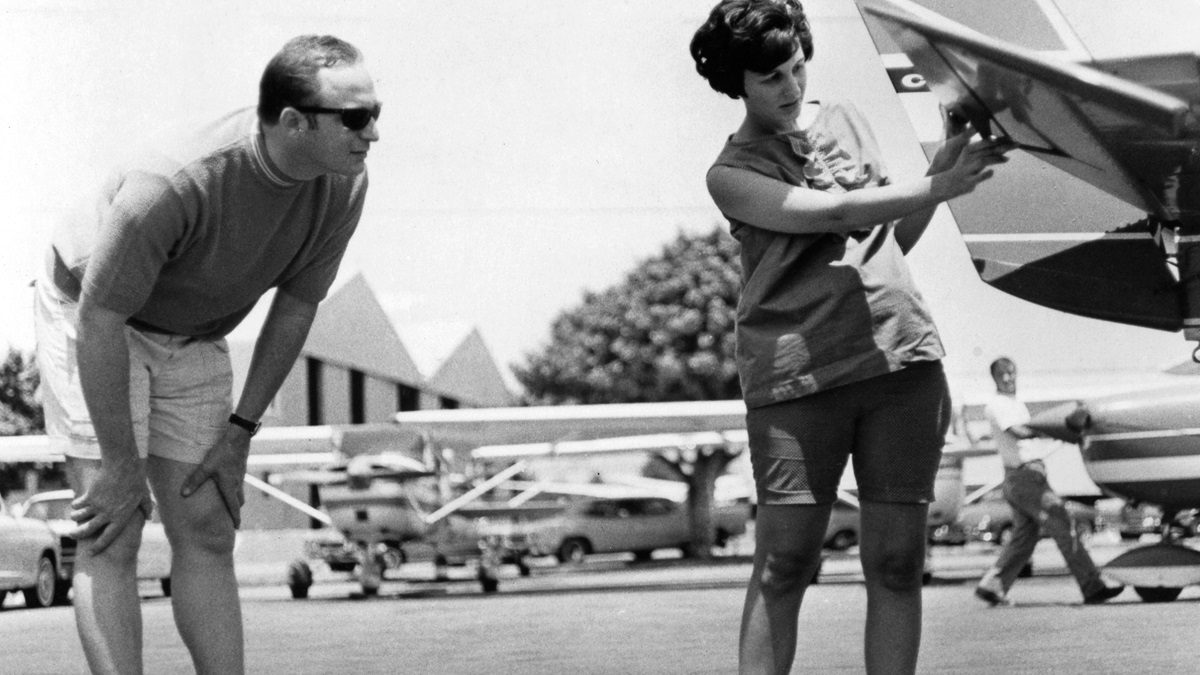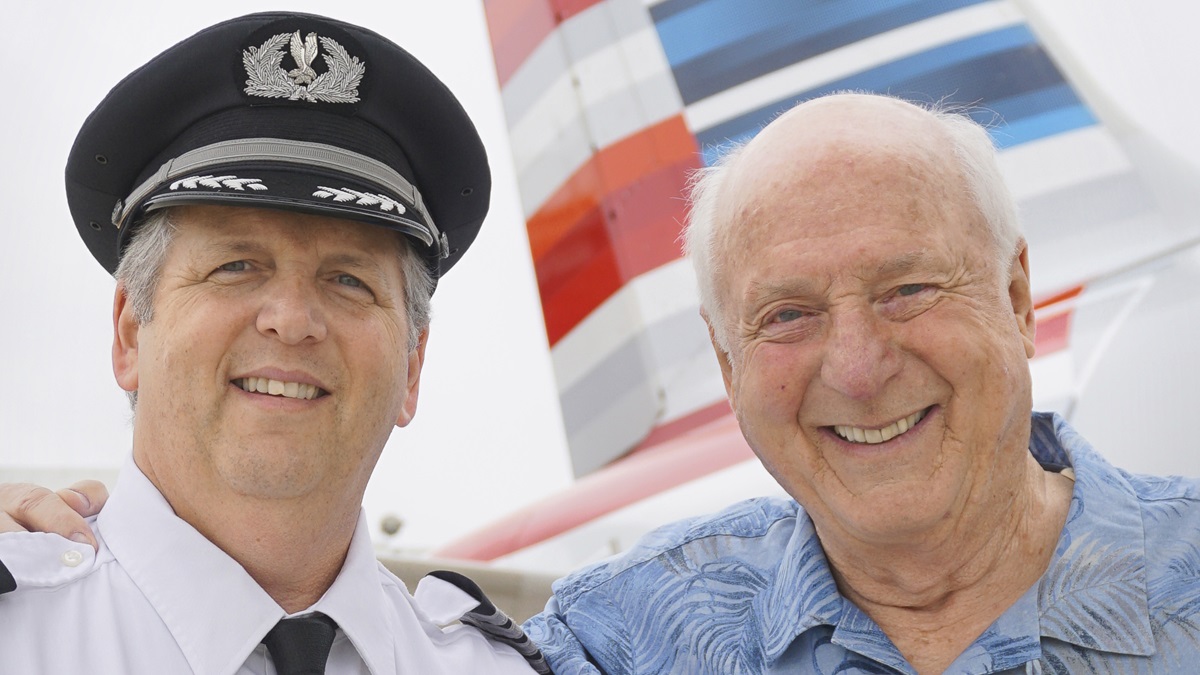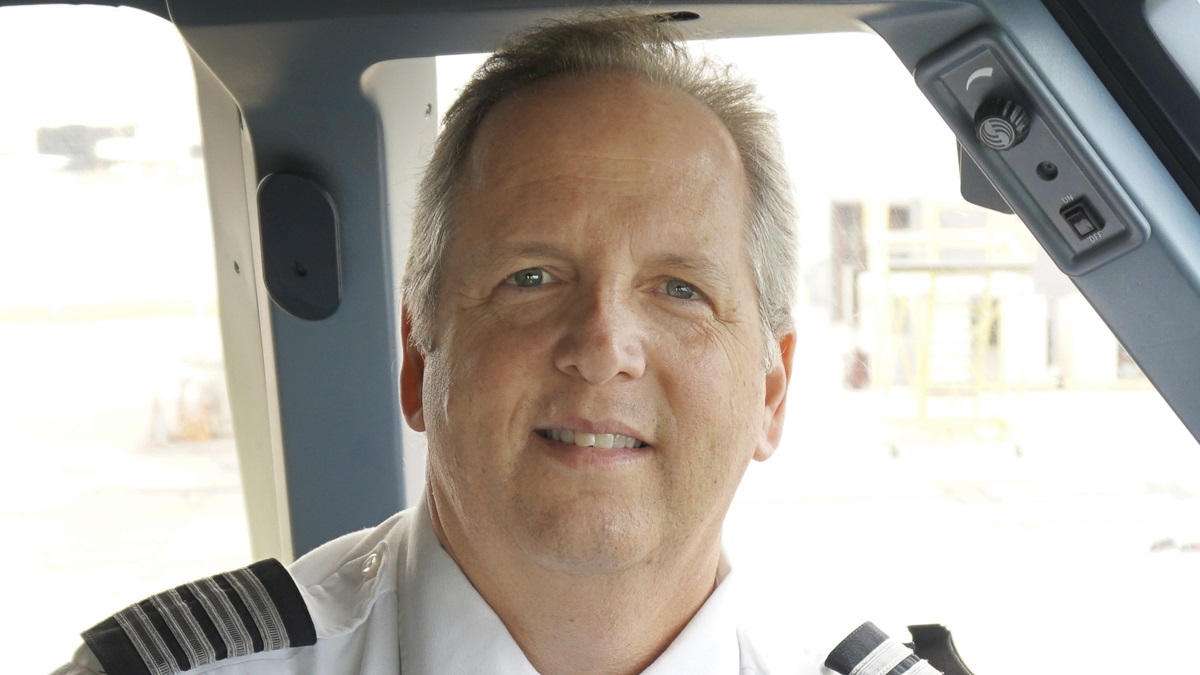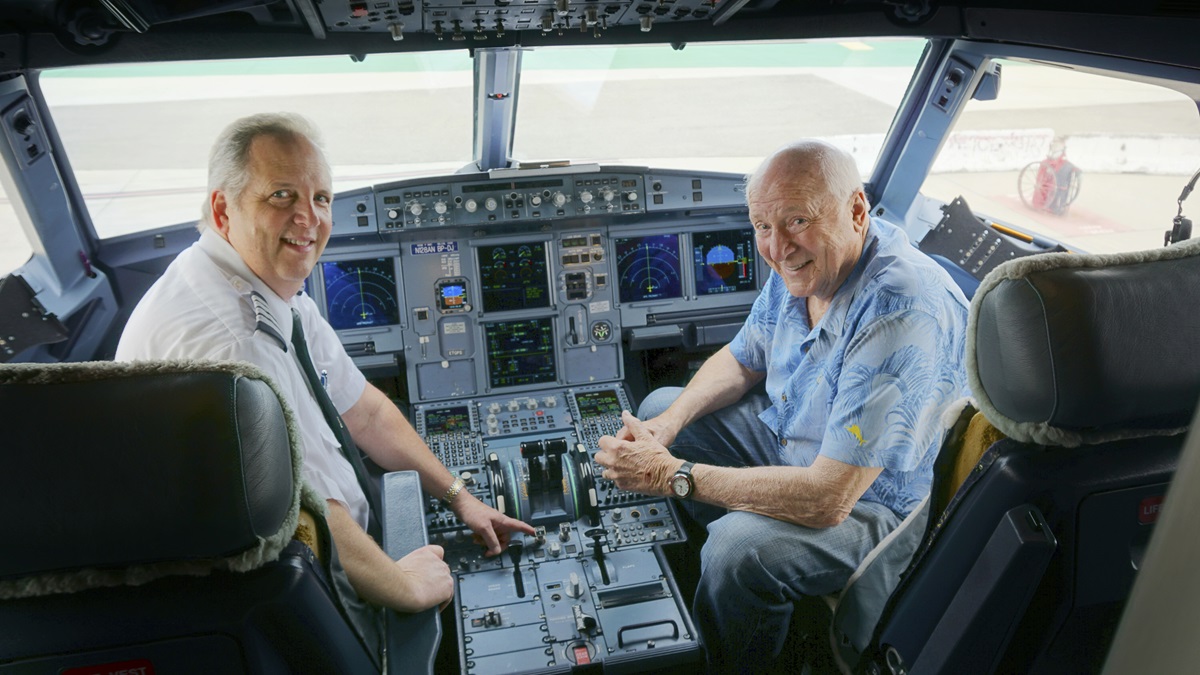Flight of passage
Celebrating Captain Schiff
I am not sitting in the cockpit, however. I was banished from that lofty perch by federal mandate on the occasion of my sixtieth birthday in 1998. This is when I was forced to retire from TWA as an ancient pelican. I am instead in the cabin along with 180 fellow travelers, and I am certain that none of them could possibly appreciate why I am so thrilled to be one of them. It is because the captain of this transpacific flight is my son, Brian. This is not only his first command flight to Hawaii, it is my first flight as his airline passenger—an occasion that should have happened much sooner were it not for the vagaries of life getting in the way.
It seems fitting that I be seated behind him today for that is the way it began in 1981, when, as my student, he occupied the forward seat of the family Citabria. It was from the rear that I yelled and shouted—we did not have an intercom—the instructions needed to mold him into an aviator. But I am not yelling today. Instead, I am quietly bursting with pride as I bear witness to my son having reached the pinnacle of his profession. The kid has come a long way.
Brian: It seems so strange for Dad to be in the passenger cabin. It had always been the other way around. I had always been his passenger or, on rare occasions, a member of his crew. I’ve had the privilege of observing his leadership skills and the comfortable manner in which he commanded a flight. I have for years tried to emulate his professionalism. And when being an airline captain requires me to make difficult decisions, I might find myself asking, what would Dad do at times like these?
I am convinced that Brian's addiction to flying was born before he was.When he boarded my flight today, I found myself feeling a little nervous and wondered if he would be impressed. I wondered if he would notice that my command style emulated his, even though I have developed many of my own techniques. I don’t think he did, but he did say that he was proud, which was a huge pat on the back. My accomplishments, though, are not mine alone. Dad encouraged, sustained, and inspired me. I hope he realizes that if I do something impressive that it has much to do to with his influence.
Brian likely would tell you otherwise, but I am convinced that his addiction to flying was born before he was. It began when I taught his mother to fly in 1967. You see, she was carrying him to term while learning, and he surely was inspired by some sort of prenatal osmosis. In fact, she was nine months pregnant when she made her first solo flight, and it was Brian who kept her safe during that flight. With him “riding along,” there was no way she could have stalled that Cessna 150 (inadvertently or otherwise)—it was simply impossible for her to bring the control wheel far enough aft.
My fascination with flying began during the many flights we took with Dad when we were kids. His enthusiasm for aviation was infectious. Sometimes, though, I got airsick. I hated that feeling but thankfully outgrew it.
When I was young, my stepmother occasionally took me to the airport to pick up Dad returning from a flight. Once we arrived early, and she drove to an area directly beneath the final approach course at L.A. to watch arrivals. I became seriously awestruck when a TWA Boeing 747 passed thunderously overhead, close enough for its wake to almost knock me over. She pointed up at that monstrous machine and screamed over the noise, “That’s your father! He’s flying that airplane!” That did it. I knew instantly what I wanted to do—what I had to do—with my life. I’ve always been thankful for having discovered while so young that I wanted to be a pilot. My focus and determination never wavered. The mere thought of being in command of an airliner and flying it to the other side of the world was compelling and consuming.
The first time Brian and I worked as crewmembers on the same airline flight was August 27, 1991. We operated a TWA Lockheed L–1011 from New York to Berlin, Germany, with Brian as the flight engineer and me as the captain. During that flight, I occasionally found myself looking back at Brian, usually when he was hunched over his small table and preoccupied with making fuel calculations or entering data in the aircraft log.
He turned around once and caught me looking his way. I pretended to be checking something on his panel, but he knew better. And I knew that he knew. We smiled at each other. Without uttering a word, I was saying, “Son, I am proud of who you are, what you have accomplished, and where you are going.” And his smile said, “Thanks for helping me get here.” These were thumbs-up smiles filled with love and respect. It doesn’t get much better than that.
Except perhaps on this flight to Hawaii.
I was 14 when I mustered the courage to ask Dad if I could learn to fly. That’s the age at which he began (but without parental consent). He said that he had been wondering if and when I was going to ask. He added that as much as he had been hoping that I would want to fly, he never wanted to suggest it for fear that I would be doing it to please him. He wanted to be certain that I wanted to fly for the right reasons, because I wanted to, not because he wanted me to. To further test my determination and make sure that I had some skin in the game, he made me pay for part of the airplane rental out of the earnings from my after-school job at a print shop. When he saw how serious I was about becoming a pilot, he bought a Citabria, but I had to pay for my own fuel.
Dad was a demanding taskmaster and would admonish me with something like, “If you can maintain 3,100 feet this well, then I’ll bet you can maintain 3,000 feet just as well.” I can still hear to this day—even from the left seat of this Airbus—echoes of him prodding me for perfection.
Our favorite flights together were to Hawaii, which is what makes today's flight so especially meaningful.I was ready to solo long before my sixteenth birthday, and having to wait tested my patience. One of Dad’s endorsements in my logbook reads, “Ready for solo. Too bad.” On the big day, our priority was for me to solo before he took me to get a driver’s license.
I’m not sure why it came as such a surprise when the flight attendant stated matter-of-factly in her welcoming announcement over the PA system that “Captain Brian Schiff is in command of our flight today,” but it did. I felt like jumping out of my seat and yelling, “Hey! That’s my son! My kid is in charge of this flight!” I didn’t, of course, partly for fear of being thrown off the airplane. Equally surreal was hearing his voice making PA announcements during the flight. The voice was stronger and so much more confident than the tentative teenage voice I had heard on my handheld radio when he called “downwind abeam the tower” during his first solo flight oh so many years ago.
The turn of the century was a period of mixed emotions for Brian. In early 2000 he joyfully became a TWA captain (on the Boeing 727). On the morning of September 11 during the following year, he had to explain to his passengers in somber tones why he had been ordered by ATC to make an immediate landing. In that same year, TWA was taken over by American Airlines, thus ending his tenure with one airline and continuing his career with another.
I became an airline pilot at the age of 21 by dropping out of school. Sacrificing my last year of college was worth the seniority that I would gain. Besides, there is no way that I could have turned down the offer from TWA to join their ranks. (I returned to school years later and completed my degree at Embry-Riddle.)
I’ll never forget my first flight as a member of Dad’s crew. After all those hours of him sitting behind me in the Citabria and gently slapping the back of my head when I screwed up, it was now my turn to sit behind him in the flight engineer’s seat and slap the back of his—in jest—a reminder of our early flights together. He even endured my insubordination when I pilfered dessert from his in-flight meal tray. Our favorite flights together were to Hawaii, which is what makes today’s flight so especially meaningful. Many of our layovers there involved him giving me dual instruction for my glider rating at Dillingham Airfield on the northwest tip of Oahu.
I spent most of my last five years with TWA wearing out the route between Hawaii and California, which adds to the sentimentality of this flight.
A favorite pastime during quiet moments on those flights over the middle of the ocean was to play The High and the Mighty on a nose flute over the air-to-air frequency. (A nose flute is a small, plastic musical instrument that you can buy for a buck and is remarkably easy to play.) I have been told that my “broadcasting” that haunting melody from the classic 1954 movie of the same name developed a far-flung reputation.
Comments made by pilots monitoring the frequency were priceless. The ghost of John Wayne’s character surely lurks in the night sky along that transpacific airway. Many of the younger pilots who heard the music didn’t have a clue, so the elders had to explain. Then the frequency would fall silent, and the dark sky would once again become lonely.
I felt like jumping out of my seat and yelling, "Hey! That's my son! My kid is in charge of this flight!"Before departing on this flight with Brian at the helm, I gave him a packet of special “flight equipment”—items not provided by his airline nor required by the FAA. Included was a nose flute with which I hope he continues the tradition.
I attribute my well-developed attitude toward aviation safety to my father. He taught me well through word and deed. I am often asked if I am related to Barry Schiff. Before answering, though, I invariably ask, “Does he owe you any money?” Following in his footsteps is challenging. He leaves large footprints separated by long strides. Because I am his son, aviation people seem to expect a lot of me, which is a good thing. It provides additional motivation to be as good a pilot and instructor as I can be. Being my father’s son has made me a better pilot.
Throughout the flight to Kona I had to fight the urge to pass a note to the cockpit to let Brian know that I was available to assist should any problems arise. It seemed a natural thing to do. A part of me still feels that I am his instructor, even though those days are obviously long gone. But isn’t a father supposed to have his son’s back? It was a foolish thought, of course. What do I know about fly-by-wire, computerized airplanes? Besides, the FAA considers me persona non grata, no longer welcome in an airline cockpit.
One of our most memorable airline flights together occurred on June 21, 1998. It was my retirement flight, and TWA management had arranged for Brian to be my first officer on that Boeing 757—a father-and-son crew. What made this even more special was that it was Father’s Day.
My present, though, was something far more precious than a tie that never gets worn. By following in my footsteps, Brian was gifting to me his tacit approval of who I am and what I do. But he is no longer following footsteps; he is blazing an enviable career path of his own. I could not be prouder of who he is and what he has become. But the most gratifying tribute is when someone asks, “Are you related to Brian Schiff?”
Editorial Note: Brian continues to move in lockstep with his father and recently purchased a Citabria with which to teach his son, Jonathan—Barry’s grandson—to fly, thus ensuring a third-generation aviator in the family.

